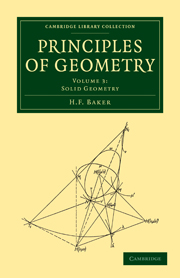Book contents
CHAPTER I - INTRODUCTION TO THE THEORY OF QUADRIC SURFACES
Published online by Cambridge University Press: 05 July 2011
Summary
Preliminary remark. We have, in previous volumes, given trouble to emphasizing the view that the use of the algebraic symbols is not necessary to the geometrical theory; and that the use of symbols of any particular system is equivalent to the adoption of definite geometrical restrictions.
It is, however, often conducive to clearness and brevity, to employ symbols; and it is usual to suppose that the symbols have the same laws of operation as the numbers of ordinary Analysis. Accordingly in the present volume we shall employ such symbols, whenever it seems desirable. The arithmetic notion of the magnitude of the symbols, and especially of infinite values, remains excluded—as indeed it is in a logical theory of Analysis; and, as heretofore, the length and congruence of geometrical lines are not employed, save in the conventional sense explained in Volume ii (Chap. V).
It will be seen that the utility of the symbols arises chiefly from the use of the equation of a quadric (or other) surface. We here deduce this from the geometrical definition of the surface. It becomes therefore an interesting problem to replace proofs depending on this equation by direct geometrical deductions from the definition.
Not much space is given in this Volume to the proof, which has already been given in Volume ii, p. 191, that a plane is represented by a single equation which is linear in the coordinates; that this is so will be readily understood from the explanation given of the equation of a line, in a plane, in Volume ii. A line, in this chapter, is generally given as the join of two points, or the intersection of two planes.
- Type
- Chapter
- Information
- Principles of Geometry , pp. 1 - 69Publisher: Cambridge University PressPrint publication year: 2010First published in: 1923



